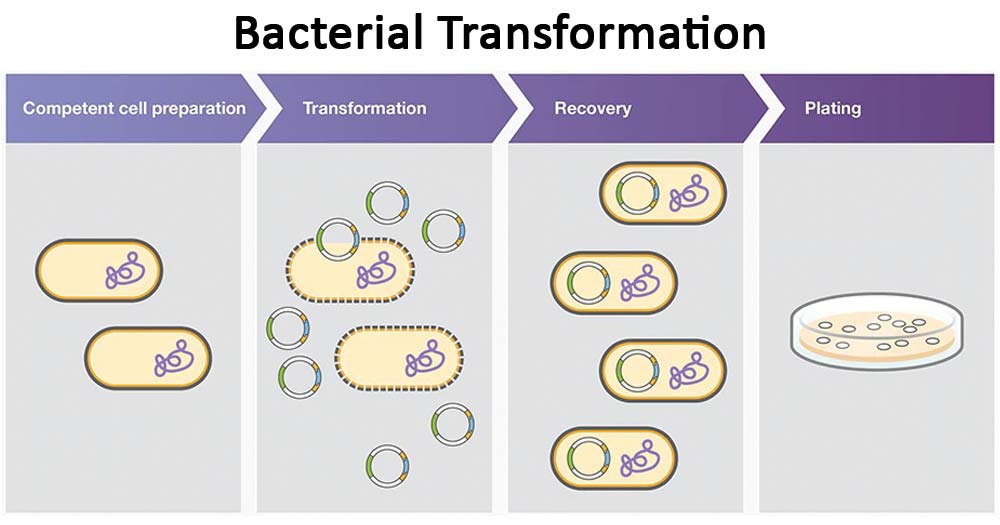Interesting Science Videos
Bacterial Transformation Definition
Bacterial transformation is the transfer of free DNA released from a donor bacterium into the extracellular environment that results in assimilation and usually an expression of the newly acquired trait in a recipient bacterium.
- This process doesn’t require a living donor cell and only requires free DNA in the environment.
- The recipient that successfully propagates the new DNA is called the transformant.
- During extreme environmental conditions, some bacterial genera spontaneously release DNA from the cells into the environment free to be taken up by the competent cells. The competent cells also respond to the changes in the environment and control the level of gene acquisition through a natural transformation process.
- Transformation is adopted as the most common method of gene transfer as it is the best way for the transfer of artificially altered DNA into recipient cells.
- The process of transformation can transfer DNA regions of one to tens of kilobases.
Bacterial Transformation Principle
- Bacterial transformation is based on the natural ability of bacteria to release DNA which is then taken up by another competent bacterium.
- The success of transformation depends on the competence of the host cell. Competence is the ability of a cell to incorporate naked DNA in the process of transformation
- Organisms that are naturally transformable spontaneously release their DNA in the late stationary phase via autolysis.
- Several bacteria, including Escherichia coli, can be artificially treated in the laboratory to increase their transformability by chemicals, such as calcium, or by applying a strong electric field (electroporation) or by using a heat shock.
- Electroporation or heat shock increases the competence by increasing the permeability of the cell wall, which allows the entry of the donor DNA.
- Similarly, transformants can be selected if the transformed DNA contains a selectable marker, such as antimicrobial resistance, or if the DNA encodes for utilization of a growth factor, such as an amino acid.
- In most of the naturally competent bacteria, the free DNA binds to the bacteria, and the DNA is integrated into the chromosomal DNA.
- Sometimes, the free DNA is inserted into a plasmid which is capable of replicating autonomously from the chromosome, and thus, the insert doesn’t have to be integrated into the chromosome.
- Plasmid encodes some enzymes and antibiotic-resistant markers which are later expressed in the transformant after transformation.
- In this process of transformation, the donor DNA is first inserted into the plasmid. The plasmid containing the donor DNA is then inserted into the competent host bacteria.
- After the transformation is completed, the bacteria containing the plasmid can be detected either by using a growth media supplemented with a particular antibiotic.
Bacterial Transformation Steps

Figure: Key steps in the process of bacterial transformation: (1) competent cell preparation, (2) transformation of cells, (3) cell recovery, and (4) cell plating. Image Source: Thermo Fisher Scientific.
- There are four steps in transformation:
- development of competence,
- binding of DNA to the cell surface,
- processing and uptake of free DNA (usually in a 3’ to 5’ direction), and
- integration of the DNA into the chromosome by recombination.
- The artificial development of competence can be achieved either through electroporation or through heat shock treatment. The choice depends on the transformation efficiency required, experimental goals, and available resources.
- For heat shock, the cell-DNA mixture is kept on ice (0°C) and then exposed to 42°C.
- For electroporation, the mixture is transferred to an electroporator and is exposed to a brief pulse of a high-voltage electric field.
- The double-stranded DNA released from lysed cells binds noncovalently to cell surface receptors. There is no DNA sequence-specific recognition; thus, these organisms can potentially incorporate DNA from outside their species.
- The bound double-stranded DNA is nicked and cleaved into smaller fragments by membrane-bound endonucleases, allowing the single strand to enter the cell through a membrane-spanning DNA translocation channel.
- The transformed DNA integrates into the chromosome and replaces the chromosomal DNA fragment by recombination. This integration, however, requires significant nucleotide sequence homology between the donating DNA fragment and the fragment in the chromosome.
- In the case of plasmid, the plasmid with the donor DNA is inserted during the heat shock or electroporation. The cells with the plasmid can be detected by growing these cells is a growth media supplemented with a specific antibiotic.
Types of Bacterial Transformation
There are two forms of transformation:
Natural Transformation
- In natural transformation, bacteria naturally have the ability to incorporate DNA from the environment directly.
Artificial Transformation
- In the case of artificial transformation, the competence of the host cell has to be developed artificially through different techniques.
Examples of Bacterial Transformation
- The first and most prominent example of bacterial transformation is the transformation of DNA from smooth capsule-positive colonies of Streptococcus pneumonia to the rough capsule-negative colonies. This was the first mechanism of bacterial genetic exchange to be recognized.
- Neisseria and H. influenzae take up DNA from their own species which occurs by species-specific recognition.
- Natural bacterial transformation is also observed in the case of B. subtilis.
References
- Verma PS and Agarwal VK (3005). Cell Biology, Genetics, Molecular Biology, Evolution and Ecology. Multicolored Edition.
- McGee, David & Coker, Christopher & Harro, Janette & Mobley, Harry. (2001). Bacterial Genetic Exchange. Doi: 10.1038/npg.els.0001416.
- Griffiths AJF, Miller JH, Suzuki DT, et al. An Introduction to Genetic Analysis. 7th edition. New York: W. H. Freeman; 2000. Bacterial transformation.Available from: https://www.ncbi.nlm.nih.gov/books/NBK21993/
- https://vlab.amrita.edu/?sub=3&brch=77&sim=1107&cnt=1
Sources
- 7% – https://www.sigmaaldrich.com/technical-documents/protocols/biology/transformation.html
- 7% – http://docshare.tips/bacterial-genetic-exchangepdf_58dd2729ee3435da3e991780.html
- 5% – https://www.researchgate.net/publication/230247422_Bacterial_Genetic_Exchange
- 2% – https://www.genetics.org/content/genetics/121/3/411.full.pdf
- 1% – https://quizlet.com/7497733/microbiology-exam-2-chapter-8-flash-cards/
- 1% – https://quizlet.com/37303154/bacterial-transformation-flash-cards/
- 1% – https://courses.lumenlearning.com/boundless-microbiology/chapter/genetic-transfer-in-prokaryotes/
- 1% – http://www.biotechnologynotes.com/gene-cloning/top-13-methods-of-gene-transfer-with-diagram/469
- <1% – https://quizlet.com/40437645/biotechnology-flash-cards/
- <1% – http://nickrath.weebly.com/uploads/6/5/4/1/6541061/steps_in_bacterial_transformation.pdf

Good express answer in brief Bacterial transformation
You work is a gift to animal scientist. May GOD bless you
The best Explanation I have ever come across. Thank you so very much!!!!!